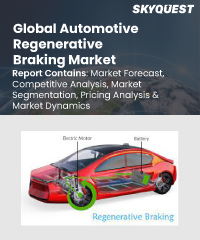
Product ID: SQMIG25C2092

Report ID:
SQMIG25C2092 |
Region:
Global |
Published Date: February, 2024
Pages:
157
|
Tables:
90 |
Figures:
74
Global Automotive Regenerative Braking Market size was valued at USD 7.62 Billion in 2022 and is poised to grow from USD 8.84 Billion in 2023 to USD 28.98 Billion by 2031, at a CAGR of 16% during the forecast period (2024-2031).
Regenerative braking systems are becoming more and more common in the automobile sector, which is mostly due to an increasing worldwide awareness of environmental sustainability issues. Automakers are under growing pressure to reduce the carbon footprints of their vehicles as concern about greenhouse gas emissions and the subsequent impact of fossil fuel consumption on climate change grows.
To battle air pollution and reduce their reliance on fossil fuels, governments throughout the world are responding to these environmental concerns by enacting strict emissions limits and fuel efficiency rules.
In order to comply with regulations, manufacturers are strongly encouraged by these regulatory frameworks to include regenerative braking systems into their car designs. For instance, the strict pollution regulations in the European Union are pressuring automakers to adopt greener technology, such as regenerative braking systems.
The market for automobile regenerative braking has been greatly boosted by the quick spread of hybrid and electric vehicles (EVs). These cars depend on regenerative braking because it helps their batteries recharge and increases their driving range.
Regenerative braking systems are in high demand as the market share of electric vehicles (EVs) increases on a worldwide scale. Increased competition in the vehicle regenerative braking industry is being caused by an increase in the number of businesses entering the market. Both established and up-and-coming suppliers to the automobile industry are fiercely vying for market dominance. This increased competition encourages innovation and cost-cutting, which eventually leads to better affordability.
US Automotive Regenerative Braking Market is poised to grow at a sustainable CAGR for the next forecast year.
Our industry expert will work with you to provide you with customized data in a short amount of time.
REQUEST FREE CUSTOMIZATIONWant to customize this report? This report can be personalized according to your needs. Our analysts and industry experts will work directly with you to understand your requirements and provide you with customized data in a short amount of time. We offer $1000 worth of FREE customization at the time of purchase.

Product ID: SQMIG25C2092